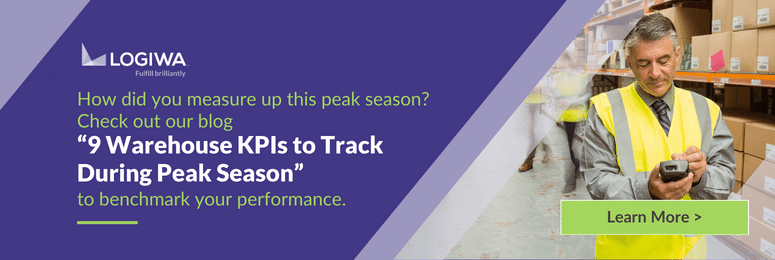Fulfillment Solutions with Erhan Musaoglu
We sat down with Logiwa Founder & CEO, Erhan Musaoglu, to discuss the importance of a fast WMS implementation and how time-to-value affects your choice of a new WMS.
How do warehouses know when it is time to consider new technologies?
What are the warning signs of a failing WMS?
Musaoglu: There are three things I would consider.
The first sign is a lack of continuous improvement. Ecommerce continues to grow at an unprecedented pace. If you cannot adapt quickly, you will not keep up. You should see ongoing improvement in the number of orders you are shipping. If not, you know it’s time to consider new technology. For example, warehouses that are still using a legacy WMS, or worse, Excel spreadsheets, are stuck with the same functionality. They can’t adapt or improve efficiency. In other words, if you have the same system, and the same measurements— next quarter you’ll have the same output. If you can’t see new information quickly or track different metrics easily, that’s when you know you need to improve your technology.
The second is your WMS’s ability to keep up with new technology – and technology is constantly evolving to keep up with the changing needs inside and outside the warehouse. Right now, we are seeing a lot of growth in robotics adoption. Warehouses recognize that to meet demands, maintain costs, and perform competitively in today’s labor market, they need to bring in this new technology. Your WMS must provide integrations with robotics solutions and enable you to take full advantage of the productivity enhancements robotics provide. And it’s not just robotics—your WMS must be prepared for the next industry advancements so that you can continue to adapt and scale.
A third area to consider is the shift from B2B to DTC fulfillment. Most systems at the moment are designed for B2B operations. Right now, there is a huge shift towards DTC models as ecommerce continues to be a growing segment within the retail industry. Fulfillment operations realize that DTC provides the opportunity for sustainable growth that B2B alone does not. B2B and DTC are two totally different worlds with vastly different requirements. So if you are a new entrant in this market, you do not want to start a DTC fulfillment network with a WMS geared toward B2B. And if you are adding DTC fulfillment as a way to expand your business, or moving away from pure B2B, then you need WMS software that is designed to handle the needs of DTC and hybrid enterprises.
You mentioned spreadsheets. How do warehouses know that their operations have outgrown management-by-spreadsheets?
Musaoglu: They need to consider the time that they are wasting. Most warehouses that are still using spreadsheets don’t realize just how much time they are losing. Time is one of the biggest gains they will see when moving to a modern WMS.
Look at the time spent on specific functions, such as billing for a 3PL. You could have 10 different clients. When billing time approaches, it could take a week or more to measure all the activity and do the necessary reporting to generate accurate billing. With a good WMS that captures and tracks the data on an ongoing basis, the process becomes seamless. Operators often overlook how much this sort of wasted time translates into hard dollar costs in their operations.
Let’s use receiving an order as another example. When you are working with a spreadsheet, you have to make a note of the product number when you first receive an order. Then you enter that number by manually typing it into the spreadsheet, along with other details like quantity. The success of this system depends entirely on accurate manual data entry. With a WMS, you simply scan a barcode and all the associated data is automatically captured. This process can be four or more times faster than manual entry.
Let’s look at reporting as another example. With spreadsheets, you often have stock discrepancies. The reason is simple: warehouses are physical environments. When you go into the warehouse and you move items from one place to another—you make notes. You then have to head back to the office and try to capture critical item details in your spreadsheet. If this information is entered incorrectly, you create all kinds of issues. You run out of stock; you oversell an item, or your customers get the wrong item entirely. A good WMS allows you to use mobile devices to handle tasks like counting, packing, transfers, and shipping. By scanning a barcode, there is no room for mistakes.
So it’s time to get a WMS. What are some important considerations when evaluating a WMS purchase?
Musaoglu: Time-to-value. This is my top criteria for selecting a WMS. First, let me say that for me, time-to-value is not just about the initial investment and how long it takes to recognize a benefit after adopting a new system. To me, offering a cloud-based SaaS product means that the benefit recognition happens again and again in a variety of ways. The value of that investment is sustainable and ongoing.
Let’s look at what I mean. In an old B2B environment, change doesn’t happen very fast. You may have the same customers for years and you have strategic agreements. The expectations are simple and your customers are more likely to tolerate mistakes and allow you time to fix them. But in an ecommerce environment, especially DTC, things change quickly.
Your customers may have no strategic alignment with you. They are simply purchasing a product from a website. If you can’t deliver on time, the customer will go elsewhere. You must not only be fast but also agile.
That is one of the beautiful things about modern warehouse management and cloud-based SaaS solutions. They can adapt to industry changes quickly. Today those changes are coming faster and faster—as new product bundles, special promotions, changes in shipping carriers, or the addition of new stores. Being able to adapt quickly is a major competitive advantage. And with each change, you reinforce time to value. Therefore, a modern WMS must be configurable. It is the only way to sustain the growth and change that DTC fulfillment providers require.
What is the difference between configurability and customization? How might that affect your choice of a WMS?
Musaoglu: If the WMS is properly designed, you should require little to no customization. The solution should consider and anticipate the needs of DTC fulfillment and be able to address your specific situation with simple configurations.
If the WMS requires a lot of customization, you’re stuck with a custom solution you will continuously need to upgrade. This costs more in the long-run. Because each change you make means more custom coding, and that means you have to pay again for those services from the solution provider. With the pace of change in the industry, you will need additional customizations often. And each time you are going to lose both time and money.
We built Logiwa WMS from the ground up as a product with ongoing innovation and sustainable value. We constantly develop new features to stay current with industry needs. We make those improvements available to everyone with each new release. And you can quickly and easily configure Logiwa to meet your specific requirements.. You get the features quickly without additional investment and without losing additional time.
Avoiding the need to spend additional money on customization or losing valuable time waiting on programming, testing and implementation makes a configurable solution the one with the most ongoing and sustainable value.
Many of the existing WMS solutions rely on a license plus services model. Why did Logiwa choose the SaaS route? What are the benefits to customers?
Musaoglu: It all comes back to time to value. In order to provide the best time to value on your initial investment and implementation, you need to have a true, multi-tenant cloud environment. This allows you to have a quick implementation. Also, this allows you to have a release cycle where you can continue getting time to value as new features roll out.
Another benefit is being able to pay as you go. Instead of requiring payment of hundreds of thousands of dollars for software that you may or not be happy with, you can subscribe to ongoing use of a cloud service. With a cloud based SaaS WMS, you pay as you go—and as you scale. This is very important when you are a startup with a small budget. We enable our clients to start small and scale as their business grows.
The speed and value of Logiwa’s WMS implementation compared to the alternatives repeatedly surprises Logiwa’s potential clients. What are your thoughts about keeping implementation costs so low?
Musaoglu: The Logiwa team has years of experience with implementations because we started out as resellers of top tier WMS systems in the traditional way. But we kept coming back to two fundamental questions: why WMS implementations took so long and why did each project require so much customization.
We realized it was in the approach to the design of the product. If we created a well-designed solution that could be easily configured, instead of needing to be customized each time, we could change the industry. This is what we’ve done with Logiwa WMS.
We designed a purpose-built product that has all the core functionalities needed to accomplish modern fulfillment. So instead of needing constant code development and customization, we can configure one parameter to fit your unique business need.
In light of a recession, is now a good time for warehouses to invest in a new system?
Musaoglu: Yes, this is exactly the time. Again, it goes back to the cost of maintenance and ongoing customization. Outdated, traditional systems are breaking the bank. Especially in a recession environment where margins are going down. An affordable, sustainable solution can support them better.
Looking for more expert insights on achieving fulfillment excellence? Follow Erhan Musaoglu on LinkedIn or contact our team of warehouse technology experts for a non-commitment demo of our industry-leading WMS.
For access to additional guides, whitepapers, case studies, videos, tools and templates, visit our resource page at: https://www.logiwa.com/resources.
Scale up B2C fulfillment operations with an integrated digital warehouse and fulfillment system
Warehouse Management
Modern digital WMS powers a modern fulfillment experience






